The silkie is such a unique chicken breed. Unlike most chicken breeds, silkies appear like they have hair instead of feathers. This is due to the unique barbless structure of each feather, giving it less form and the ability to flow freely.
But because of this unique feather structure, distinguishing between the male and female silkie can be tricky – but not impossible. So in this article, you’ll learn how to tell them apart.
Silkie roosters are easier to spot, owing to their longer crest and wing feathers and large walnut-shaped comb. In contrast, silkie hens have a rounded crest and a v-shaped comb. Also, silkie roosters tend to be louder and more aggressive than the more reserved silkie hens.
And that’s just the tip of the iceberg. There are quite a considerable number of distinctions between the silkie hen and the rooster. Continue reading for more information.
What Are Silkie Chickens? Where Do They Originate?
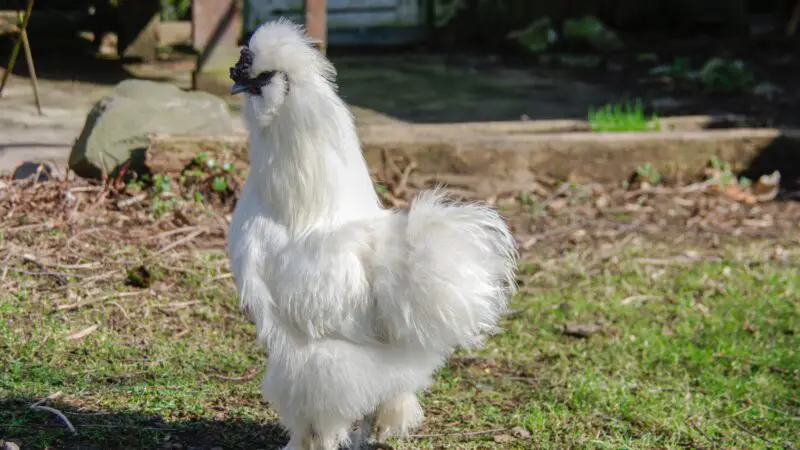
The silkie, otherwise spelled as silky, is a chicken breed that’s known for its unique hair-like feathers. This breed is known as a fancy chicken breed owing to its unique qualities. They are also calm and friendly, which makes them great pets.
While they are good egg producers, silkie hens tend to be broody, and that disrupts their egg-laying cycle. But on average, they can produce around 100 eggs.
Additionally, the silkie is a small chicken breed. An adult silkie only weighs around two to four pounds. As a result, their carcass does not produce a lot of meat.
However, silkie meat is highly regarded in some Asian communities because it is believed to possess medicinal properties. As such, silkie chicken soup is quite popular in China.
Aside from their unique plumage, the silkie is also known for its black skin. Even its wattles and combs are dark-colored, often in the dark blue to the plum range. This is due to fibromelanosis, which is a condition that causes melanin to be distributed throughout the body – thereby giving it dark-colored skin, bones, and including its organs.
Interestingly, the origins of the silkie, including how it developed such unique physical characteristics, remain unknown. However, it is considered one of the oldest chicken breeds, especially since there are records of sightings of a furry chicken in Asia as early as the 13th century.
With its early origins in China, it is still unclear how it made its way to the West. But because of the silkie’s unique appearance, it inevitably became a popular breed. And in 1874, it was eventually accepted into the American Standard of Perfection.
Related: What Is a Silkie Chicken? | Information and Facts
How Can You Tell if a Silkie Is Male or Female? | Distinct Differences
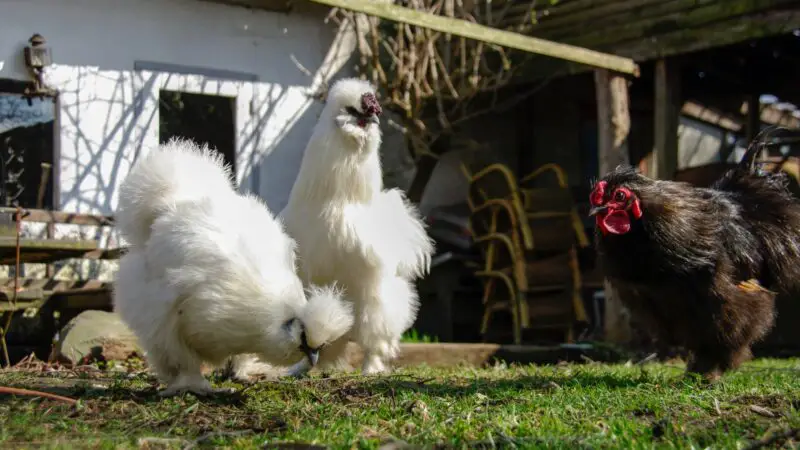
There are quite a few differences between male and female silkies. In general, the male is slightly taller and bigger than the female. They also tend to have longer feathers, thereby appearing fluffier.
But that’s not all. There are several other differences between the silkie hen and the rooster, including their appearance, size, and behavioral characteristics.
Appearance
One of the biggest ways to distinguish a silkie rooster from a hen is its physical appearance. Aside from the fluffier appearance of the male silkie, they are also known to have longer crest feathers that grow in different directions. This makes them look like they have an unkempt crown.
Another way to distinguish the rooster from the hen is by looking at their comb. A silkie rooster has a large walnut-shaped comb, while the hen has a small v-shaped comb.
Additionally, a silkie rooster has a large wattle. This is as opposed to the hen’s smaller, sometimes lacking, wattle.
In some instances, silkie roosters also grow spurs, while the hens never grow them.
Size
The male silkie is also taller and heavier than the female silkie. On average, a male silkie can grow up to 14 inches tall. In contrast, a hen can only grow between 8 to 12 inches.
Additionally, a silkie rooster can weigh up to four pounds. This is opposed to the female silkie, which can weigh up to three pounds.
Color
There’s no difference between silkie hens and roosters as far as plumage and skin color are concerned. All silkies have fibromelanosis, giving their skin and organs that iconic black color. Also, all silkies may have either white, black, partridge, buff, gray, or splash plumage.
Habitat
As far as habitat is concerned, both silkie hens and roosters need enough space to forage and roam around. But most importantly, they need a sturdy coop to shelter them from the rain.
Behavior and characteristics
Another easy way to tell the silkie hens from the rooster is their behavior. The silkie rooster is territorial in nature, and that makes them more aggressive than the hens. Roosters also crow in the morning, while hens do not.
Another way to tell them apart is that hens tend to get broody. This is especially true during their laying cycle. As a result, you will rarely see hens outside of their coop during this period.
To summarize, here is a table of differences between the silkie rooster and the silkie hen for your reference:
| Silkie Rooster | Silkie Hen | |
| Noise | Crows quite loudly | Generally quiet, and mostly only clucks |
| Appearance | Looks fluffier, owing to their longer feathers | More rounded body |
| Territorial | Yes | No |
| Behavior | Alert, has a tendency to be aggressive but is generally friendly and docile | Generally friendly and docile but tends to get broody during its laying cycle |
| Size | Taller and heavier | Smaller and lightweight |
| Combs | Walnut-like shaped | V-shaped |
| Wattles | Larger wattles that grow early | Smaller wattles that grow late |
| Spurs | Can grow chicken spurs | Does not grow chicken spurs |
At What Age Can You Tell the Gender of a Silkie Chicken?
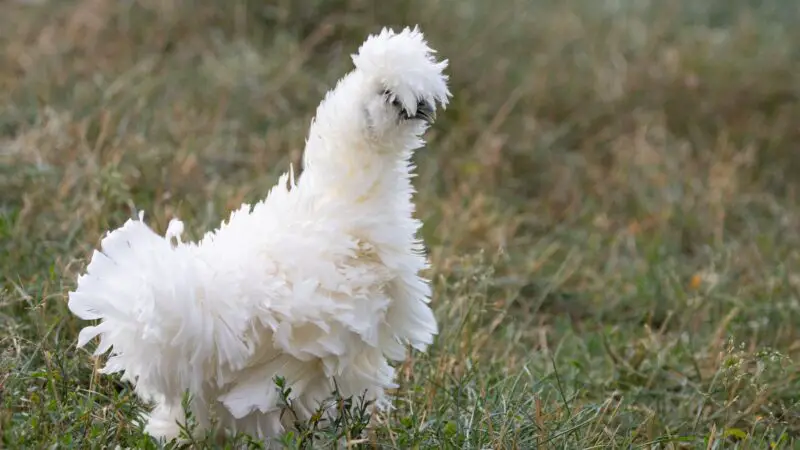
You will be able to tell the gender of the silkie chicken by the time it reaches three months old. By this age, the male silkies will start to grow their crest feathers. These feathers are long, thin, and messy, which is a far cry from the hen’s neat rounded crest feathers. But by this age, the female silkie does not have crest feathers yet.
Also, the silkie crow will already start crowing at three months. This is one of the first tell-tale signs that the young chicken is a rooster.
Silkie Chicken Care Guide
Give them enough space to forage. Silkies love to forage. This is how they get their nutrition and exercise, so make sure that they have an area that’s big enough for them to roam around.
Make sure they always have access to clean water. Aside from giving them the space to forage, they should also have access to clean drinking water. This ensures that they will never be dehydrated.
Make sure to have them checked for lice and mites. Because their feathers have a hair-like texture, silkies are often susceptible to lice and mites. Thus, it’s important to have them checked for these insects to keep them healthy and stress-free.
Take them to the vet regularly. To ensure that they are always in their best health, it’s best to get them checked by a veterinarian regularly.
Make sure they have a well-protected coop. The fact that their feathers are not as structured as regular feathers mean that they are not protected against the rain and the cold. With that said, make sure that their coop is safe and comfortable enough to help them get through rainy days and the freezing winter season.
Silkie Colors
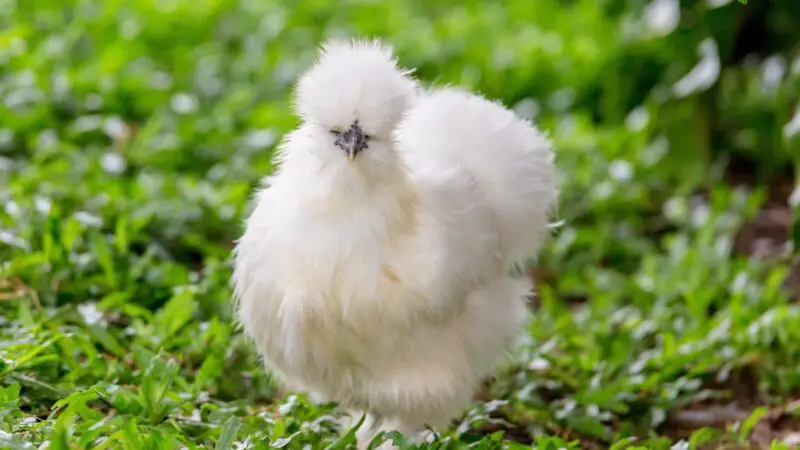
Silkie chickens come in a variety of plumage colors. This includes white, black, partridge, buff, blue, gray, and splash. Their plumage only has one solid color and does not have any pattern – although the feathers in the wing area tend to be darker than the rest of its body.
As for their skin color, silkies have fibromelanosis, giving them dark-colored skin and organs. This includes dark blue to dark purple wattles, combs, beaks, legs, and feet.
What Is the Rarest Color of Silkie Chicken?
The rarest silkie chicken color is red. Interestingly, it is not a usual silkie variety. Instead, it is a rare color that results from cross-breeding a buff-colored silkie with another silkie variety.
What Is the Most Popular Silkie Color?
The most common silkie color is pure white, which is even considered the ideal standard for silkies. Interestingly, the white plumage results from a recessive gene and can be lost when breeding conditions are not controlled.
How Do I Get a Blue Silkie Chicken?
The blue-colored silkie is not a usual variety. It results from breeding the black silkie with a splash silkie. The resulting chicks will have dark-colored feathers with a lovely bluish hue, which is considered a diluted form of the parent chicken’s plumage color.
Pros and Cons in Raising Silkie Chickens
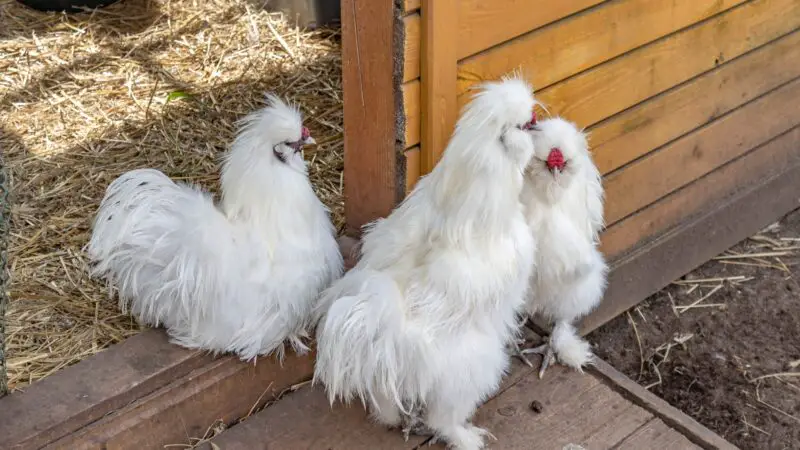
Pros
- Silkies are gentle and friendly. Because of their docile temperament, make great pets. They have no problem with being held, which makes them great around curious children.
- Silkies are ornamental. Silkies are unique, and that adds to their charm. Because of this, they are sought-after as an ornamental breed.
- They are easy to care for. Despite not being a breed that can withstand rainy days, silkies are still quite hardy. That makes them a low-maintenance breed that’s easy to care for.
Cons
- They need protection from the rain. A bird’s standard feather has barbs that give it its iconic shape. This feather structure helps to protect them against external factors – including cold and rain. Since a silkie’s feather does not have the usual feather structure, they are not protected from the rain. They also lack the thermal insulation offered by the standard feather structure.
- They are prone to bullying and predators. Because of their gentle nature, silkies often get bullied or fall prey to some predators.
What Are Silkie Chickens Good For?
Silkie chickens make great pets. They are docile, friendly, and sociable, making them great with children and other pets. Being a fancy ornamental breed, silkies are also great for exhibitions or poultry shows.
Despite the silkie’s small size, it produces meat that has an exotic flavor that’s similar to duck. However, breeding a silkie for meat is not as popular as raising it for show or as a pet.
And while they can produce a decent number of eggs per year, their eggs are quite small, and the hens tend to go broody. Thus, they are not always bred for egg-laying.
Are Silkie Chickens Rare?
While silkie chickens are unique, they are not rare or endangered. But even if they are not under any conservation status, it is advised to take care of this breed, especially considering its heritage status.
How Much Are Silkie Chickens Worth?
An adult silkie chicken sells for around $15 to $50, regardless of its gender. The difference in the price usually lies in the silkie’s lineage, as well as the reputation of the breeder. If you prefer buying silkie chicks instead, they usually sell for about $3 to $10, depending on their lineage.
Do Silkie Chickens Like to Be Held?
Silkie chickens like to be held. They are among the known chicken breeds that are friendly and sociable, so they don’t mind being cuddled.
They are also quite calm and gentle, so they will not attack you for no reason. However, this is especially true for the silkie hen since the silkie rooster tends to become territorial.
How Many Eggs Do They Lay?
A single silkie hen can produce around 100 to 120 cream-colored eggs every year. That’s roughly about three to four eggs every week during its laying cycle. However, this number can be smaller if the hen becomes broody.
Are Silkie Chickens Purebred?
Silkies are considered purebred chickens. In fact, they are even considered one of the oldest purebred chickens in the world.
List of Sources
Assessing MHC-B Diversity in Silkie Chickens
A cis-Regulatory Mutation of PDSS2 Causes Silky-Feather in Chickens
